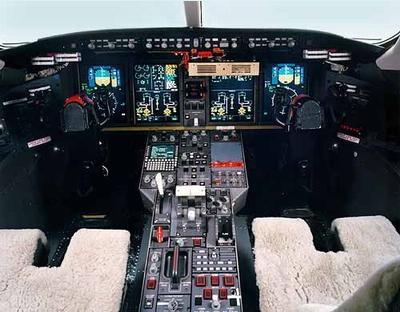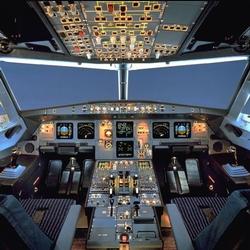Tue, Jun 17, 2003
Pro Line 21 Certifiedon Challenger 300;
GLU-920 Multi-Mode Receiver (MMR) and Stack in Egypt Air
A-330s
 A Collins Pro Line 21 advanced avionics system
received U.S. Federal Aviation Administration and Transport Canada
certification onboard the new Bombardier Challenger 300
super-midsize aircraft; and Rockwell Collins' suite of data link
communications, navigation and surveillance sensors, including the
GLU-920 Multi-Mode Receiver (MMR), as well as the Collins WXR-2100
Multiscan Weather Radar will be seen in Egypt Air's seven new
Airbus A330 aircraft. (That's in addition to the April announcement
about the company's providing avionics for Egypt Air's five new
Airbus A320-200 aircraft.)
A Collins Pro Line 21 advanced avionics system
received U.S. Federal Aviation Administration and Transport Canada
certification onboard the new Bombardier Challenger 300
super-midsize aircraft; and Rockwell Collins' suite of data link
communications, navigation and surveillance sensors, including the
GLU-920 Multi-Mode Receiver (MMR), as well as the Collins WXR-2100
Multiscan Weather Radar will be seen in Egypt Air's seven new
Airbus A330 aircraft. (That's in addition to the April announcement
about the company's providing avionics for Egypt Air's five new
Airbus A320-200 aircraft.)
The latest Egypt Air agreement calls for installation of
Rockwell Collins' suite of data link communications, navigation and
surveillance sensors, including the GLU-920 Multi-Mode Receiver
(MMR). The Collins WXR-2100 Multiscan Weather Radar was also
selected for these new aircraft.

On the Challenger (above), Rockwell Collins, as the aircraft's
avionics system integrator, was responsible for all aspects of the
avionics program, from design through certification. The flight
deck features four 12- by 10-inch liquid crystal flight displays,
consolidated control panels and more efficient operation, and
integrates a number of advanced technologies, including TCAS II and
terrain awareness warning systems as standard equipment.
Situational awareness is further enhanced through options such as
turbulence-detection weather radar and 3-D Flight Management System
navigation maps. The Bombardier Challenger 300 is the first new
aircraft platform to be equipped with Collins Pro Line 21 CNS
sensors, which support the transition from voice to data
communications. The new sensors are significantly smaller and
lighter than existing sensors, conserving space for future avionics
technology insertions.
 The Challenger's avionics suite includes the
Collins Engine Indication and Crew Alerting System (EICAS) to
monitor, analyze and display performance of aircraft engines and
other on-board systems. Linkage of EICAS monitoring capabilities to
the aircraft's maintenance diagnostic computer permits aircraft
systems performance and maintenance data to be sorted, logged and
analyzed, enhancing operations and simplifying maintenance.
The Challenger's avionics suite includes the
Collins Engine Indication and Crew Alerting System (EICAS) to
monitor, analyze and display performance of aircraft engines and
other on-board systems. Linkage of EICAS monitoring capabilities to
the aircraft's maintenance diagnostic computer permits aircraft
systems performance and maintenance data to be sorted, logged and
analyzed, enhancing operations and simplifying maintenance.
The Egypt Air/Airbus (A320 cockpit, lower photo) avionics
package's GLU-920 Multi-Mode Receiver (MMR) provides the aircraft's
primary position, velocity and time reference, and enables
precision landing capability. It offers Instrument Landing System
(ILS) capability and high-integrity satellite-based positioning for
navigation and future landing functions, and offers growth to
support Microwave Landing System (MLS) capability. The Collins MMR
can meet future air traffic management requirements while offering
commonality across fleet types.
More News
Decision Altitude (DA) A specified altitude (mean sea level (MSL)) on an instrument approach procedure (ILS, GLS, vertically guided RNAV) at which the pilot must decide whether to >[...]
Aero Linx: T-34 Association, Inc. The T-34 Association was formed in July 1975 so that individuals purchasing then military surplus T-34As had an organization which would provide s>[...]
As He Released The Brakes To Begin Taxiing, The Brake Pedals Went To The Floor With No Braking Action Analysis: The pilot reported that during engine start up, he applied the brake>[...]
“Legislation like the Mental Health in Aviation Act is still imperative to hold the FAA accountable for the changes they clearly acknowledge need to be made... We cannot wait>[...]
Also: IAE Acquires Diamond Trainers, Army Drones, FedEx Pilots Warning, DA62 MPP To Dresden Tech Uni The danger to the flight training industry and our future pilots is clear. Dona>[...]
 ANN's Daily Aero-Term (12.08.25): Decision Altitude (DA)
ANN's Daily Aero-Term (12.08.25): Decision Altitude (DA) ANN's Daily Aero-Linx (12.08.25)
ANN's Daily Aero-Linx (12.08.25) NTSB Final Report: Piper PA-31T3
NTSB Final Report: Piper PA-31T3 Aero-News: Quote of the Day (12.08.25)
Aero-News: Quote of the Day (12.08.25) Airborne-Flight Training 12.04.25: Ldg Fee Danger, Av Mental Health, PC-7 MKX
Airborne-Flight Training 12.04.25: Ldg Fee Danger, Av Mental Health, PC-7 MKX





